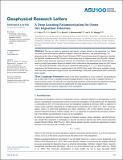A Deep Learning Parameterization for Ozone Dry Deposition Velocities
Author(s)
Silva, Sam James; Heald, Colette L.; Ravela, Sai; Mammarella, I.; Munger, J. W.
DownloadPublished version (656.8Kb)
Publisher Policy
Publisher Policy
Article is made available in accordance with the publisher's policy and may be subject to US copyright law. Please refer to the publisher's site for terms of use.
Terms of use
Metadata
Show full item recordAbstract
The loss of ozone to terrestrial and aquatic systems, known as dry deposition, is a highly uncertain process governed by turbulent transport, interfacial chemistry, and plant physiology. We demonstrate the value of using Deep Neural Networks (DNN) in predicting ozone dry deposition velocities. We find that a feedforward DNN trained on observations from a coniferous forest site (Hyytiälä, Finland) can predict hourly ozone dry deposition velocities at a mixed forest site (Harvard Forest, Massachusetts) more accurately than modern theoretical models, with a reduction in the normalized mean bias (0.05 versus ~0.1). The same DNN model, when driven by assimilated meteorology at 2° × 2.5° spatial resolution, outperforms the Wesely scheme as implemented in the GEOS-Chem model. With more available training data from other climate and ecological zones, this methodology could yield a generalizable DNN suitable for global models.
Date issued
2019-01Department
Massachusetts Institute of Technology. Department of Civil and Environmental Engineering; Massachusetts Institute of Technology. Department of Earth, Atmospheric, and Planetary SciencesJournal
Geophysical Research Letters
Publisher
American Geophysical Union (AGU)
Citation
Silva, S. J., Heald, C. L., Ravela, S., Mammarella, I., & Munger, J. W. (2019). A deep learning parameterization for ozone dry deposition velocities. Geophysical Research Letters, 46, 983–989. https://doi.org/10.1029/2018GL081049
Version: Final published version
ISSN
1944-8007
0094-8276